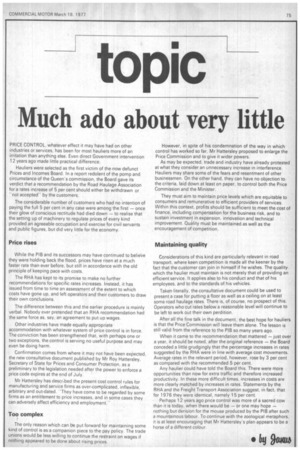t op ic
Page 77

If you've noticed an error in this article please click here to report it so we can fix it.
Much ado about very little
PRICE CONTROL, whatever effect it may have had on other industries or services, has been for most hauliers more of an irritation than anything else. Even direct Government intervention 12 years ago made little practical difference.
Hauliers were selected as the first victim of the now defunct Prices and Incomes Board. In a report redolent of the pomp and circumstance of the Queen's commission, the Board gave its verdict that a recommendation by the Road Haulage Association for a rates increase of 5 per cent should either be withdrawn or -not acceptedby the customers.
The considerable number of customers who had no intention of paying the full 5 per cent in any case were among the first — once their glow of conscious rectitude had died down — to realise that the setting up of machinery to regulate prices of every kind provided an agreeable occupation and exercise for civil servants and public figures, but did very little for the economy.
Price rises
While the PIB and its successors may have continued to believe they were holding back the flood, prices have risen at a much faster rate than ever before, but still in accordance with the old principle of keeping pace with costs.
The RHA has kept to its promise to make no further recommendations for specific rates increases. Instead, it has issued from time to time an assessment of the extent to which costs have gone up, and left operators and their customers to draw their own conclusions.
The difference between this and the earlier procedure is mainly verbal. Nobody ever pretended that an RHA recommendation had the same force as, say, an agreement to put up wages.
Other industries have made equally appropriate accommodation with whatever system of price control is in force. The conviction has been strengthened that, with perhaps one or two exceptions, the control is serving no useful purpose and may even be doing harm.
Confirmation comes from where it may not have been exPected, the new consultative document published by Mr Roy Hattersley, Secretary of State for Prices and Consumer Protection, as a preliminary to the legislation needed after the power to enforce a price code expires at the end of July.
Mr Hattersley has described the present cost control rules for manufacturing and service firms as over-complicated, inflexible, arbitrary and out-dated. ''They have come to be regarded by some firms as an entitlement to price increases, and in some cases they can adversely affect efficiency and employment.
Too complex
The only reason which can be put forward for maintaining some kind of control is as a companion piece to the pay policy The trade unions would be less willing to continue the restraint on wages if nothing appeared to be done about rising prices. However, in spite of his condemnation of the way in which control has worked so far, Mr Hattersley proposed to enlarge the Price Commission and to give it wider powers.
As may be expected, trade and industry have already protested at what they consider an unnecessary increase in interference. Hauliers may share some of the fears and resentment of other businessmen. On the other hand, they can have no objection to the criteria, laid down at least on paper, to control both the Price Commission and the Minister.
They must aim to maintain price levels which are equitable to consumers and remunerative to efficient providers of services. Within this context, profits should be sufficient to meet the cost of finance, including compensation for the business risk, and to sustain investment in expansion, innovation and technical improvement. Quality must be maintained as well as the encouragement of competition.
Maintaining quality
Considerations of this kind are particularly relevant in road transport, where keen competition is made all the keener by the fact that the customer can join in himself if he wishes. The quality which the haulier must maintain is not merely that of providing an efficient service. It applies also to his conduct and that of his employees, and to the standards of his vehicles.
Taken literally, the consultative document could be used to present a case for putting a floor as well as a ceiling on at least some road haulage rates. There is, of course, no prospect of this. Operators who cut rates below a reasonable level will continue to be left to work out their own perdition.
After all the fine talk in the document, the best hope for hauliers is that the Price Commission will leave them alone. The lesson is still valid from the reference to the PIB so many years ago.
When it came to the recommendation that mattered — just over a year, it should be noted, after the original reference — the Board conceded a little grudgingly that the percentage increases in rates suggested by the RHA were in line with average cost movements. Average rates in the relevant period, however, rose by 3 per cent as compared with the recommended 5 per cent.
Any haulier could have told the Board this. There were more opportunities than now for extra traffic and therefore increased productivity. In these more difficult times, increases in costs are more clearly matched by increases in rates. Statements by the RHA and the Freight Transport Association suggest, in fact, that for 1976 they were identical namely 15 per cent.
Perhaps 12 years ago price control was more of a sacred cow than it is today, when there would be — or one may hope — nothing but derision for the mouse produced by the PIB after such a mountainous labour. To continue with the zoological metaphors, it is at least encouraging that Mr Hattersley's plan appears to be a horse of a different colour.




























































































































